What is 2k Moulding? The Lowdown on a very Innovative Process
February 1, 2021

2k moulding is one of the most innovative processes in use in plastics manufacturing today. Although the concept has been around for many decades, as with all tech processes, there have been a lot of technological advances in the use of 2k moulding in recent times. With a wide set of applications, it has many practical uses. In this guide, we’ll explore the benefits of 2k moulding and look at one industry (of many) that’s deploying it successfully. But first…
What is 2k moulding?
2k moulding – sometimes known as double injection or 2 shot moulding – is a very innovative way to produce complicated moulded parts from 2 different materials. It’s a highly meticulous, specialised and automated manufacturing process which controls the injection of multiple materials.
It is specialised because it involves the combination of hard and soft thermoplastics or thermoplastic (TP) and thermoplastic elastomer (TPE).
It’s applicable to a broad range of products; think medical devices, keys on a computer keyboard and even all the specific parts that go into a car’s headlights.

There are many other potential uses for it too. For example, it can be used to improve the grip on product handles – for items like power drills, toothbrush’s, walkie talkie’s etc. Plastics are integrated into the product grip and this can be done through the use of 2k moulding.
How does 2k moulding work?
Simply put, the plastic moulding technology blends 2 materials or 2 different colour materials into one ending plastic part by using a specific 2k injection moulding machine. This machine has the power to take two totally different polymers and transform them into a single, final product.
A chemical bonding process is required so that the two or more materials can be combined into one component. The strategic choice of materials are a fundamental factor for the project’s success or not when using 2k injection moulding. Also, throughout this process, it’s vital to use the appropriate classification of cleanroom, given the type of product you are creating.
What about the 2k Moulding Machine?
2k moulding is performed on one machine which is programmed to perform 2 injections in one cycle.
In the first cycle, a nozzle injects plastic into a mould. The mould is then automatically rotated and a different type of plastic is injected into the mould from a second nozzle.
The 2k moulding machine can create a highly effective end result from very different polymers.
What Equipment and tools are required?
A 2k moulding machine needs to be kitted with multiple injection screws; either a rotating tool, a transfer tool and/or a moving core tool; and any other required supporting equipment. (You may need to consider a tooling transfer for everything to run smoothly.)
What’s the difference between 2k moulding and overmoulding?
A common question. Let’s first define overmoulding.
Overmoulding is also a type of injection moulding process that allows for the combination of two or more different materials into a single product. This usually includes a rigid, plastic-base component overlaid with a pliable, thin rubber-like thermoplastic elastomer (TPE) exterior layer or other materials using either a 1 shot (insert moulding) or 2 shot (2k) technique.
The main differences between overmoulding and 2k moulding can be summarised as follows:
- Overmoulding can be both a single shot (insert moulding) or two-shot. 2k moulding is just a 2 shot process.
- Production volume. 2k tends to be a lot bigger than overmoulding and is used for larger operations.
- In the overmoulding process, the material used must be cold to be removed. However with 2k moulding, the polymer is typically still flexible and hot – therefore it allows for more greater functionality.
- 2k moulding allows for large number of materials that can act as the moulding substance or equally be moulded on. With overmoulding, you are more restricted with the usable materials.
What are the Benefits of 2k Moulding?
There are many advantages to 2k moulding including:
- Versatility. Due to the nature of 2k moulding, this process can be used for a variety of product designs across different industries. This could be cameras, automotive parts, power switches, medical devices etc. (More on medical devices below.)
- Improved quality. As the moulding uses clear plastics, coloured graphics and neat finishes, it has multi-material efficiency. Furthermore it can be more durable and more aesthetically pleasing as many colours can be blended in the manufacturing process.
- Increased product value and marketability. This multi-material efficiency of course improves the utilitarian aspect of the product and thus its overall marketplace value.
- Expense. 2k moulding is a streamlined process which allows for a lower price per unit… as all manufacturing procedures are completed in the injection stage.
- Time. With no secondary processing, there is a gain in cycle time with it being a constant process. The end results means less assembly time & greater efficiency.
- Reduced handling and secondary assembly. For example it’s less likely that you will have to prime, paint or coat the product afterwards.
- Reduces cost and waste associated with potential assembly defects.
- Enhanced tactile and cosmetic product features.
These are the main benefits associated with 2k moulding. While the counter argument and potential drawback is that the mould for 2k moulding and running the 2k moulding machine is more expensive… where high volume is needed, the overall cost and time can be significantly lower, thanks to a greater reduction in overall assembly and labour costs.
2k Moulding Design Considerations
Choosing the right material is very important. While 2k moulding certainly gives you more liberty in your creative expression, there are still fundamentals to adhere to. Take note of what plastics you are combining as some potentially may work better together than others. Factors such as viscosity and environmental protection are all things to consider from the outset.

Source: ResearchGate
If the 2 given materials are not compatible either physically or chemically – the end result will inevitably be a sub-par product… with deformation or other bonding issues like delamination where the different materials fall apart.
In summary, there are numerous other nuances to consider in the design process such as parting lines and the draft angle. However starting off in the right manner with the correct material choice will inevitably set the tone for the project. This is critical for every project, particularly when it comes to medical devices.
Medical Devices and 2k Moulding
Given the importance and delicate nature of medical devices, the need for precision and care is of paramount importance when it comes to medical device manufacturing. And when doing this in large volumes – this is key.
One of the most typical materials when it comes to medical devices is silicone. When producing silicone based medical devices – liquid injection moulding is often the go-to process. However beyond this, many medical devices now require substances such as liquid silicone rubber. It is here with the combination of other engineered plastics, that 2k moulding can be used.
This combination of materials in medical devices is often required for a more robust and high quality end product.
What are the Benefits of 2k Moulding for Medical Devices?

The most obvious advantage is that it can allow for the creation of the most complex and innovative products. As mentioned before, you are largely free to use the best materials for a given product. As the most complex parts will require different materials for different functions.
For example, medical device housings will require a material that is strong and durable but equally something that has a certain aesthetic appeal. Likewise any device handpiece (for example a thermometer) needs to provide good grip but also be sturdy.
Generally, many medical devices require both the hard and soft that 2k moulding delivers.
In addition to all the main benefits of 2k moulding listed above – medical devices can also stand to gain better physical properties such as UV shielding, resistance to drug migration into a plastic wall and resistance to certain media. (Many manufacturers are now also integrating antimicrobial plastics into their end-products when it comes to medical devices).
So what are some typical medical devices that use 2k Moulding?
Some examples include… syringe piston seals, medical devices houses, stem connectors, IVD cartridges, sealings (integrated into devices), handheld medical devices, manifolds for pharmaceutical filling lines and many more…
Final thoughts on Medical Devices and 2k Moulding
Medical device manufacturing through 2k moulding is a very precise and intricate process. From being in a tailored cleanroom for medical devices to selecting the right materials for the end-product is fundamental. In order to deliver potentially transformational medical devices, requires an investment in a high tech 2k moulding machine. However the biggest advantage of 2k moulding for medical devices (and other sectors) is that it saves you overall time and assembly costs plus giving greater freedom to create a durable and aesthetically pleasing product tailored to your needs.
Looking for 2k Moulding to create a better but more cost-effective product?
The 2K moulding process has the power to manufacture and design highly complex and multiple material parts. If you want to take advantage of this innovative technology, please get in touch with us.



